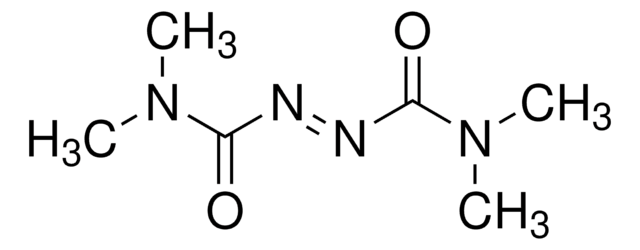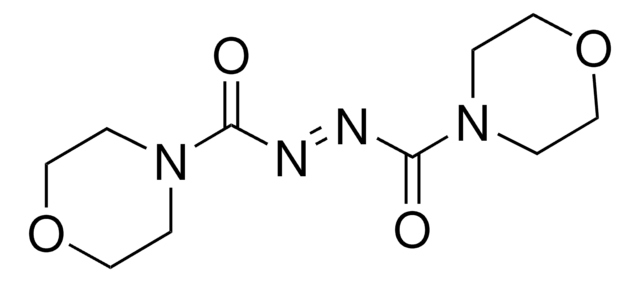255920
1,1′-(Azodicarbonyl)dipiperidine
99%
Synonym(s):
1,1′-Azobis(N,N-pentamethyleneformamide), ADD, Azodicarboxylic acid dipiperidide, NSC 356027, SR 4077
About This Item
Recommended Products
Quality Level
Assay
99%
form
solid
mp
134-136 °C (lit.)
functional group
azo
SMILES string
O=C(\N=N\C(=O)N1CCCCC1)N2CCCCC2
InChI
1S/C12H20N4O2/c17-11(15-7-3-1-4-8-15)13-14-12(18)16-9-5-2-6-10-16/h1-10H2/b14-13+
InChI key
OQJBFFCUFALWQL-BUHFOSPRSA-N
Application
- Polyfluoroalkylated tripyrazolylmethane ligands
- (-)-Hygromycin A via Mitsunobu glycosylation
- Optically active α,α-disubstituted amino acids via Mitsunobu reaction
- Aza-β-lactams through [2+2] cycloaddition reactions
- Glycosyl disulfides
- Pyridine ether PPAR agonists
- S-glycosyl amino acid building blocks for combinatorial neoglycopeptide synthesis
- Histamine H3 receptor antagonists
Reactant for:
- Mitsunobu inversion reactions
Signal Word
Warning
Hazard Statements
Precautionary Statements
Hazard Classifications
Eye Irrit. 2 - Skin Irrit. 2 - STOT SE 3
Target Organs
Respiratory system
Storage Class Code
11 - Combustible Solids
WGK
WGK 3
Flash Point(F)
Not applicable
Flash Point(C)
Not applicable
Personal Protective Equipment
Regulatory Listings
Regulatory Listings are mainly provided for chemical products. Only limited information can be provided here for non-chemical products. No entry means none of the components are listed. It is the user’s obligation to ensure the safe and legal use of the product.
JAN Code
255920-VAR:
255920-BULK:
255920-1G:
255920-5G:
255920-25G:
Choose from one of the most recent versions:
Already Own This Product?
Find documentation for the products that you have recently purchased in the Document Library.
Articles
One of the most powerful and widely used carboncarbon bond forming reactions in organic synthesis is the Mitsunobu reaction.
Our team of scientists has experience in all areas of research including Life Science, Material Science, Chemical Synthesis, Chromatography, Analytical and many others.
Contact Technical Service









